Sensitivity of the Simulation of Tropical Cyclone Size to Microphysics Schemes
Kelvin T.F.CHANand Johnny C.L.CHAN
School of Energy and Environment,City University of Hong Kong,Hong Kong
(Received 17 August 2015;revised 19 April 2016;accepted 27 April 2016)
Sensitivity of the Simulation of Tropical Cyclone Size to Microphysics Schemes
Kelvin T.F.CHAN∗and Johnny C.L.CHAN
School of Energy and Environment,City University of Hong Kong,Hong Kong
(Received 17 August 2015;revised 19 April 2016;accepted 27 April 2016)
The sensitivity of the simulation of tropical cyclone(TC)size to microphysics schemes is studied using the Advanced Hurricane Weather Research and Forecasting Model(WRF).Six TCs during the 2013 western North Pacific typhoon season and threemainstreammicrophysics schemes–Ferrier(FER),WRFSingle-Moment 5-class(WSM5)andWRFSingle-Moment 6-class(WSM6)–are investigated.The results consistently show that the simulated TC track is not sensitive to the choice of microphysics scheme in the early simulation,especially in the open ocean.However,the sensitivity is much greater for TC intensity and inner-core size.The TC intensity and size simulated using the WSM5 and WSM6 schemes are respectively higher and larger than those using the FERscheme in general,which likely resultsfrom more diabatic heating being generated outside the eyewall in rainbands.More diabatic heating in rainbands gives higher in fl ow in the lower troposphere and higher out fl ow in the upper troposphere,with higher upward motion outside the eyewall.The lower-tropospheric in fl ow would transport absolute angular momentum inward to spin up tangential wind predominantly near the eyewall,leading to the increment in TC intensity and size(the inner-core size,especially).In addition,the inclusion of graupel microphysics processes(as in WSM6)may not have a significant impact on the simulation of TC track,intensity and size.
tropical cyclone,microphysics,size,intensity,track,numerical modelling
1. Introduction
The size of a tropical cyclone(TC)is an important quantity to describe how large its area of in fl uence is.Studying TC size can therefore help in our understanding of the destructive potential brought by a TC.By making use of observational data,for example,best-track data,aircraft reconnaissance measurements,satellite-derived and infrared imageries,the climatology of TC size has been well studied in recent decades,especially over the western North Pacific and North Atlantic(e.g.Merrill,1984;Kimball and Mulekar, 2004;Yuan et al.,2007;Chavas and Emanuel,2010;Chan and Chan,2012,2015a;Kna ffet al.,2014).Although the de finition of TC size diff ers among some studies,significant seasonal and spatial variation in TC size has been observed,and found to be related to TC lifetime,ENSO,and subtropical high activity.By making use of numerical experiments and reanalysis data,TC size has been found to be sensitive to the lower-tropospheric absolute angular momentum transport(Chan and Chan,2013),environmental humidity(Hill and Lackmann,2009),surface entropy fl ux (Xu and Wang,2010a),initial vortex size(Xu and Wang, 2010b;Chan and Chan,2014),planetary vorticity(Smith et al.,2011;Chan and Chan,2014),vortex intensification (Kna ffet al.,2014;Chan and Chan,2015b),spiral rainbands (Wang,2009;Fudeyasu and Wang,2011;Wang,2012)and outer winds(Chan and Chan,2015b).
Owing to increased model resolution(e.g.Miyoshiet al.,2010),improved physical parameterizations,ensemble forecasting techniques(e.g.Krishnamurtiet al.,1997;Goerss,2000;Srinivas et al.,2007),and the availability of highquality satellite-derived data,especially over the data-scarce ocean(e.g.Leslie et al.,1998),the ability of NWP models to forecast the TC track has increased substantially(e.g.Rogers etal.,2006;Rappaportetal.,2009).TCbogussing(e.g.Kurihara et al.,1990;Heming et al.,1995;Leslie and Holland, 1995)and enhanced initialization techniques,including data assimilation(e.g.Zou and Xiao,2000;Torn,2010),have also helped.However,improvement in the ability to forecast TC intensity and size has been rather minimal.In fact,to the best of our best knowledge,there are no published studies that examined forecasting skill with respect to TC size.
Given this knowledge gap,the present study represents a first step toward investigating how well NWP models can predict TC size;specifically,by examining the diff erences in simulated TC size using diff erent mainstream microphysics schemes currently available:Ferrier(FER;Rogers et al., 2001);WRF Single-Moment five-class(WSM5;Hong et al., 2004);and WRF Single-Moment six-class(WSM6;Hong et al.,2006).Fovell and Su(2007)tested the Kessler(Kessler, 1995),Lin(Lin et al.,1983;Chen and Sun,2002),WRFSingle-Moment three-class(WSM3;Hong et al.,2004)and WSM5 microphysicsschemesand suggestedthat theyappear to directly or indirectly modulate vortex characteristics,including size and winds,at a large radius,and possibly other factors involved in TC motion.Fovell et al.(2009)further revealed that the in fl uence of microphysics and hydrometeor falling speeds on radial temperature gradients could lead to diff erentouterwindstrengths andtracks when using an idealized model.Cloud microphysicalprocesses may also emerge through cloud-radiative feedback(Fovell et al.,2010).On the other hand,many other studies have shown that microphysics schemes do not have any significant impact on track forecasts,but do have more of an e ff ect on the simulated TC intensity(e.g.Yang and Ching,2005;Zhu and Zhang,2006; Liand Pu,2008;Tao et al.,2011).They also found that simulated TCs have their strongest deepening or intensification when using warm-rain physics only(e.g.Wang,2002;Yang and Ching,2005,Zhu and Zhang,2006;Liand Pu,2008). However,how widely-used microphysics schemes might affectthesimulationofTC sizeremainsunknown;andaddressing this issue is the objective of this study.
In section 2,the model con figuration and experimental design are described.The model results are compared and analyzed in section 3.And finally,conclusions and a discussion are presented in section 4.
2. Model con figuration and experimental design
The Advanced Hurricane Weather Research and Forecasting Model(WRF,known also as AHW),version 3.6,is employed to simulate six TCs in the 2013 western North Pacifictyphoonseason.Theyare:Soulik,Usagi,Danas,Wipha, Francisco and Haiyan.These six cases are chosen because theyhada lifetimeofmorethanthreedays,reachedhurricane force at least once during their lifetime,and their tracks were diverse enough to represent the general spread of tracks over the western North Pacific(Fig.1).The same typhoon season is chosen so as to minimize the uncertainty from diff erent data assimilation techniques used in diff erent years.All six TC cases have diff erent initial size.Note also that six cases are used in this study,rather than a single case,because this could increase the robustness of the conclusions.
The model domain is triple-nested with two-way interactive nesting and with the inner meshes automatically vortexfollowing.The horizontal grid resolutions are 36,12 and 4 km,and the corresponding domain sizes are 9360×6840, 1440×1440and 840×840 km2,respectively.The outermost static domain is centered at(23.5°N,140°E),which is broad enough to cover all the TC cases and the western North Pacific.Themodelhas36verticaleta(η)levels,withhighervertical resolutionin the planetaryboundarylayer,and the reference model top pressure is 20 hPa.Complex topography and land–sea contrast are included.The initial and lateral boundary conditions are respectively initialized and six-hourly updated from the NCEP Final OperationalGlobal Analysis data [FNL;1°(lat)×1°(lon)].
For the model physics,the unified Noah land surface model(Tewariet al.,2004),MM5(The PSU/NCAR mesoscale model)similarity surface layer physics(Jim´enez et al.,2012)and YonseiUniversity(YSU)planetary boundary layer scheme(Hong et al.,2006)are employed.The Rapid Radiative Transfer Model for general circulation models(RRTMG)radiation scheme(Iacono et al.,2008)is taken to model the shortwave and longwave radiation physics.The Tiedtke cumulus parameterization scheme(Tiedtke,1989; Zhang et al.,2011)is used for the outer two domains(36 and 12 km)only.To be more in line with recent research results regarding tropical storms and hurricanes,the modified surface bulk drag(Donelan et al.,2004)and enthalpy coefficients(Brutsaert,1975)are applied in all domains.
Three mainstream microphysics schemes that are widely used in the community—Ferrier(FER;simple three-class ice;Rogers et al.,2001),WRF Single-Moment five-class (WSM5;two-class ice;Hong et al.,2004),and WRF Single-Moment six-class(WSM6;three-class ice;Hong et al., 2006)—are employed for the sensitivity tests in this study. FER is currently an operational microphysics scheme in NCEPmodels,andisasimpleandefficientschemewithdiagnostic mixed-phase(ice,snow and graupel)processes,while thephaseprocessesarealldistinctinWSM5andWSM6.The major diff erence between the WSM5 and WSM6 schemes is thattheWSM6schemeincludesadditionalmicrophysicsprocesses related to graupel.All other physical schemes and model settings are the same in all the experiments.More details of WRF physics and dynamics can be found in Skamarock et al.(2008).Results from 18 experiments in total (six TC cases with three microphysics schemes)are compared to examine how the microphysics scheme a ff ects the simulation of TC size.
The model con figuration and experimental design of the present study are summarized in Table 1.The details of the six TC simulations are listed in Table 2.To minimize the uncertainty and in fl uence of other factors that can a ff ect or be a ff ected by TC track on the TC size,e.g.the environmental synoptic fl ow around a TC(Chan and Chan,2013)and the planetary vorticity(Chan and Chan,2014),the first 72 hours of model results are mainly discussed in this study.Results within the first three days shouldbe largelyrepresentativebecause the mean track error at 72 h(T72)of the simulations is~170 km(i.e.~1.5°latitude),which is largely acceptable. The best-track data used in this study are based on those from the Joint Typhoon Warning Center.
3. Results
Previous studies have suggested that synoptic fl ows arounda TC(e.g.LiuandChan,2002;Chan andChan,2013) and the TC inner-core–inducedintensification(e.g.Chan and Chan,2014)can a ff ect TC size,which imply that TC track and intensity should also be examined when examining TC size.Hence,the impacts of the microphysics schemes onthe simulations of TC track,intensity and size are discussed simultaneously.
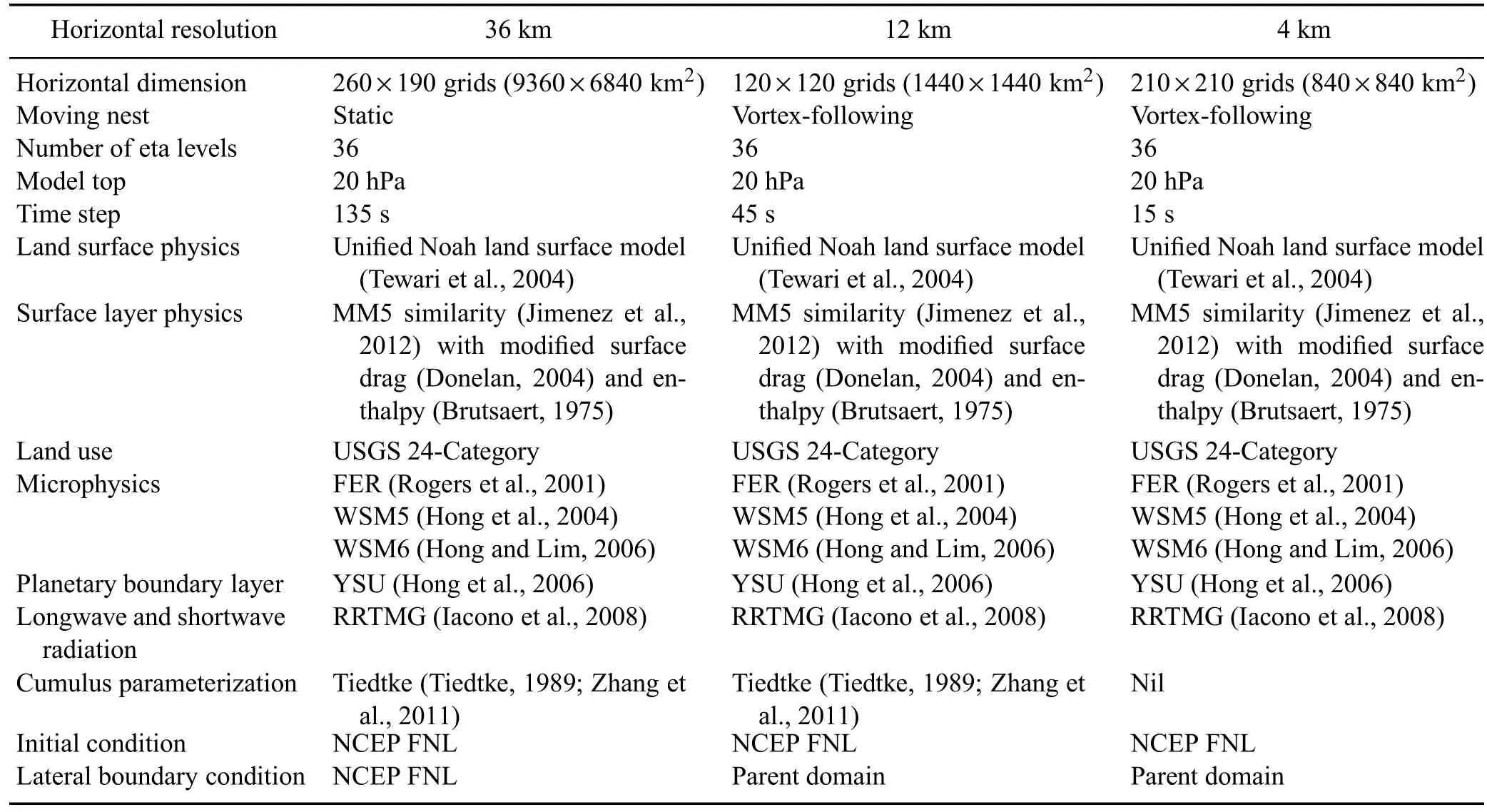
Table 1.Summary of the WRF V3.6 model con figuration.
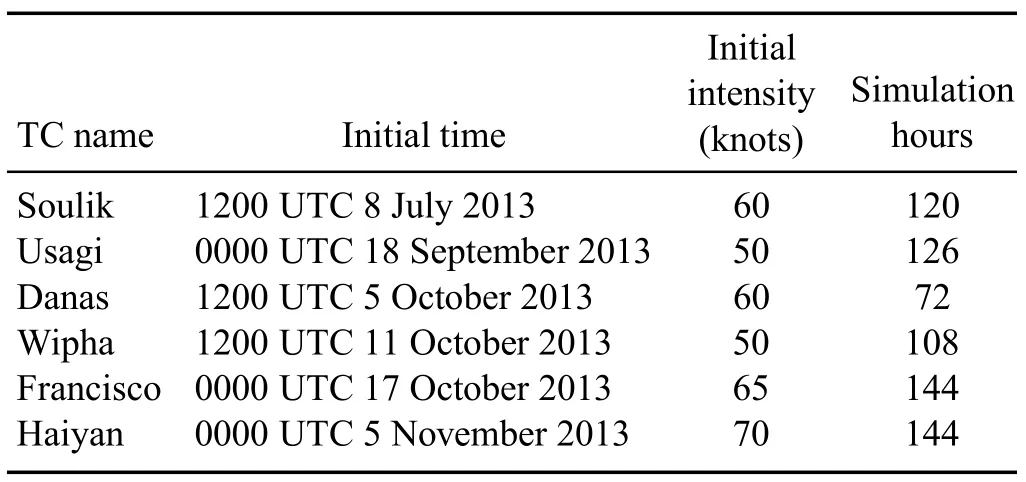
Table 2.Summary of the TCs tested.
3.1. Track
Consistent with the findings from many previous studies(e.g.Yang and Ching,2005;Zhu and Zhang,2006;Liand Pu,2008;Tao et al.,2011),the simulated TC tracks are not sensitive to the microphysics schemes(Fig.1)in general, especially in the first 72 h when the TCs are over the open ocean where the in fl uence of the landmass and topography on TC track is limited.This result suggests that the choice of the microphysics scheme among FER,WSM5 and WSM6 is likely not important in simulating the subtropical high in the early simulation,as the latter is a main factor in steering the TC.
3.2. Intensity
The trends of the simulated TC intensity largely agree with the best-track data in the first 72 h,but the minimum sea-level pressure(MSLP)is generally higher than observed [~20 hPa higher at 48 h of simulation(T48)on average;not shown].As the main objective of this study is to investigate the impacts ofmicrophysicsschemes onthe simulationof TC size,the diff erence between the simulated and observational TC intensity is not examined further.Instead,the comparisons among the three schemes on their simulations of TC intensity are discussed below.
The model results suggest that the simulated TC intensity can be in fl uenced by the choice of microphysics scheme.The TCs in the simulations with the WSM5 and WSM6 schemes are found to have lower MSLP than those with the FER scheme during the first 72 h in general(Fig. 2a).A higher maximum wind is attained for the TCs with the WSM6 scheme on average(Fig.2b).For example,for Soulik,the WSM5 and WSM6 schemes give lower MSLP than that from the FER scheme throughout the entire simulation(Fig.3a)although the diff erences in maximum wind are not that obvious in this case(Fig.3b).The azimuthally averaged lower-tropospheric in fl ow and upper-tropospheric out fl ow between 25 and 48 h in the simulations with the WSM5 and WSM6 schemes are generally higher than those with the FER scheme(Fig.4).Chan and Chan(2013)found that the change in TC intensity is positively related to the change in the upper-level angular momentum export,while the change in TC size is positively proportionalto the change in the lower-tropospheric angular momentum import.Chan and Chan(2015b)further showed that the inner-core induced intensification is favorable for size growth.Inner-core induced intensification mainly results from the inner-core dynamics:for example,an increase in upper-tropospheric outfl ow leads to a decrease in surface pressure,and thus it favors the lower-troposphericin fl owneartheinnercoreso thatmoreangular momentum is transported towards the vortex center and consequently yields an expansion of horizontal wind fields.
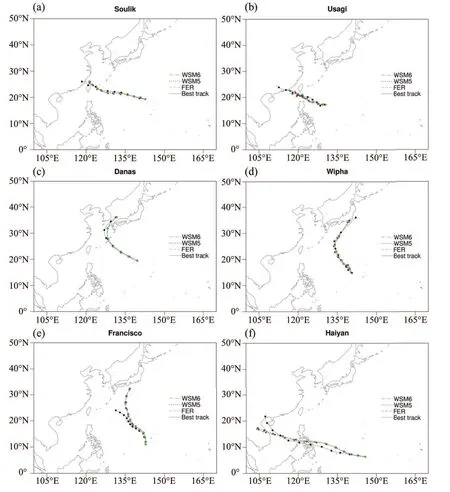
Fig.1.Summary of TC tracks with diff erent microphysics schemes in diff erent TC cases.
All the six TC cases in this study possess inner-core–induced intensification in the early simulation.The stronger upper-tropospheric out fl ow found in the simulations with WSM5 and WSM6 may be attributable to the greater diabatic heating generated outside the eyewall in the rainbands (Fig.5).Wang(2009),Fudeyasu and Wang(2011)and Wang (2012)suggested that greater diabatic heating in rainbands gives higher in fl ow in the lower troposphere and higher outfl ow in the upper troposphere(Fig.4),with higher upward motion(Fig.6)outside the eyewall.The lower-tropospheric in fl ow would transport absolute angular momentum inward to spin up tangential wind predominantly near the eyewall (Fig.7),leading to the increase in TC intensity and size(see TC size de finition and details of the sensitivity of TC size to microphysics in sections 3.3 and 3.4).This is consistent with the convectionsuch that more precipitation is found for TCs using the WSM5 and WSM6 schemes(Fig.8).All theseresultsimplythattheWSM5andWSM6 schemescould drive a stronger secondary circulation than the FER scheme and therefore result in a higher TC intensity.Such circumstances are also generally found in other cases and thereforenot shown.
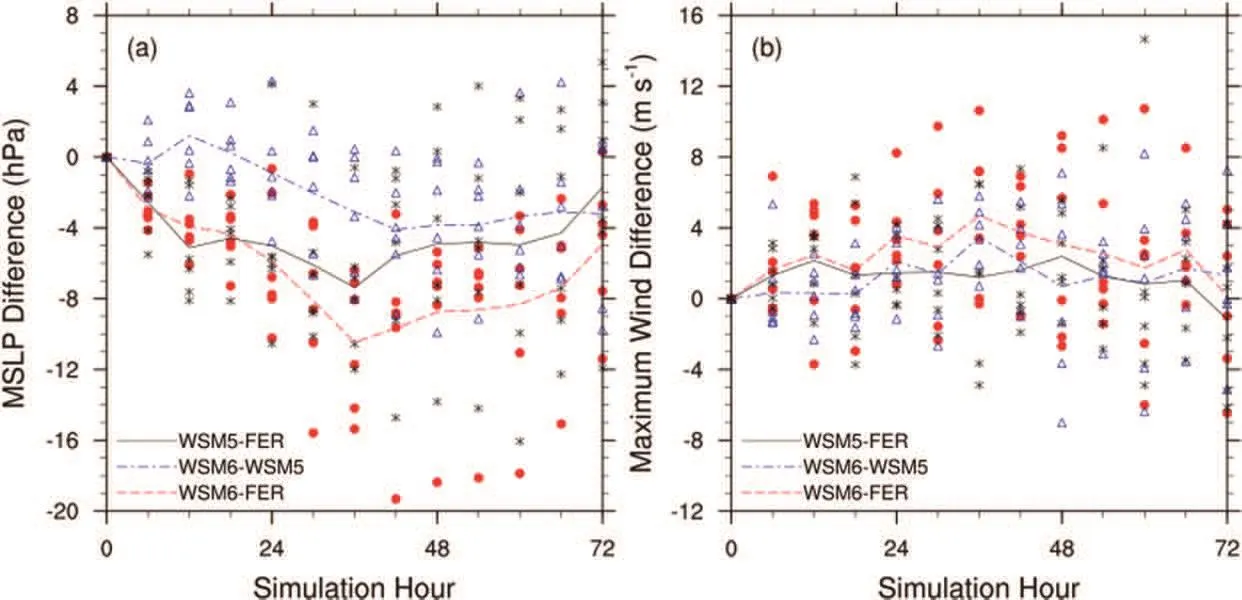
Fig.2.Diff erences among the microphysics schemes for(a)MSLP and(b)maximum wind in the first 72 h of six TC simulations.Black asterisks,blue triangles and red dots are the spreads of diff erences between WSM5and FER,WSM6 and WSM5,and WSM6 and FER from the 6 TC simulations,respectively.Black solid,blue dash-dotted and red dashed lines indicate their means,respectively.
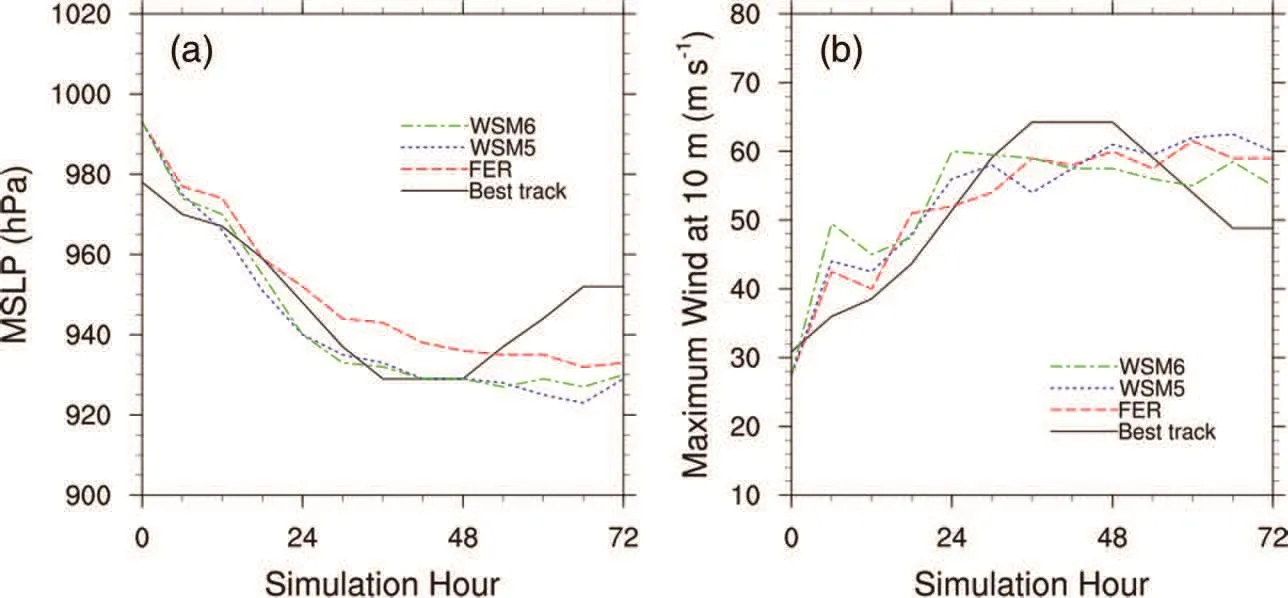
Fig.3.Time-series of(a)MSLP and(b)maximum wind of Soulik with diff erent microphysics schemes.
3.3. Size
An important result of this study is that TCs in the simulations with the WSM5 and WSM6 schemes are found to be generally larger than those with the FER scheme during the first 72 h of the simulation(Fig.9).This suggests the selection of microphysics scheme can lead to diff ering simulations of TC size.In the early simulation,vortices can be assumed to experience almost the same environmental in fl uence(as evidenced from section 3.1)so that the e ff ects of the peripheral synoptic fl ows,environmental humidity and planetary vorticity(e.g.Liu and Chan,2002;Hill and Lackmann, 2009;Chan and Chan,2013,2014)on the TC size diff erence might be negligible.Therefore,the factor or factors leading to such size diff erences likely relate to the inner-core microphysics processes.
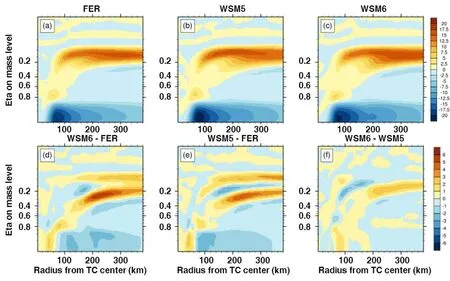
Fig.4.Radius–height plots of the 24-h averaged azimuthal mean radial wind(units:m s-1)between T25 and T48 in the case of Soulik among the(a)FER,(b)WSM5 and(c)WSM6 microphysics schemes.Negative and positive values indicate in fl ow and out fl ow,respectively.Panels(d–f)are the diff erences of the results shown in(a–c);see the titles of the plots for details of the subtractions.Note that the contour scales between(a–c)and(d–f)are diff erent.
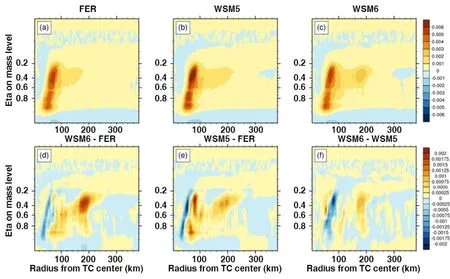
Fig.5.As in Fig.4 but for diabatic heating(units:K s-1)due to microphysics.In(a–c),negative and positive values indicate absorption and generation,respectively.
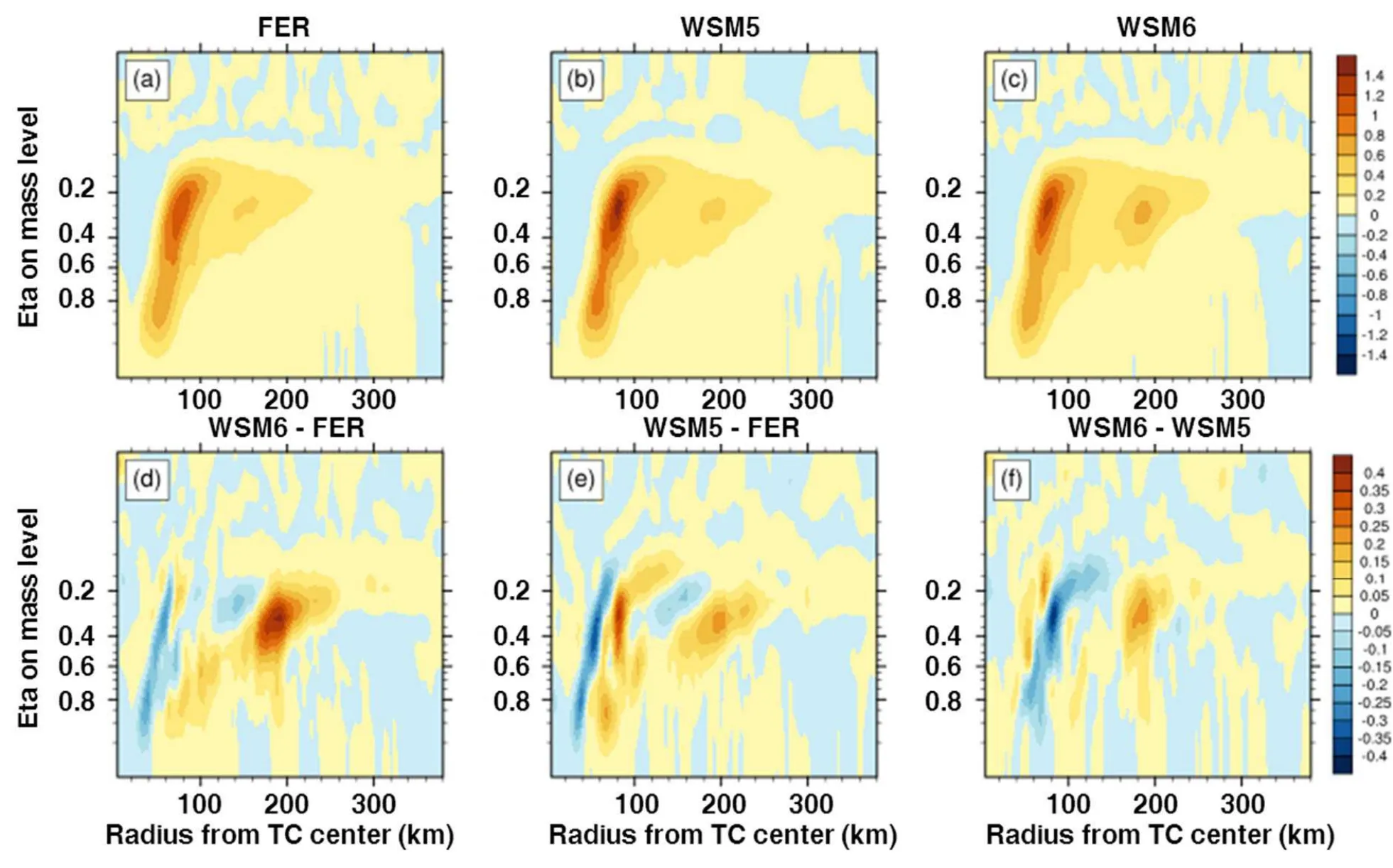
Fig.6.As in Fig.4 but for vertical wind(units:m s-1).In(a–c),negative and positive values indicate downward and upward motions,respectively.
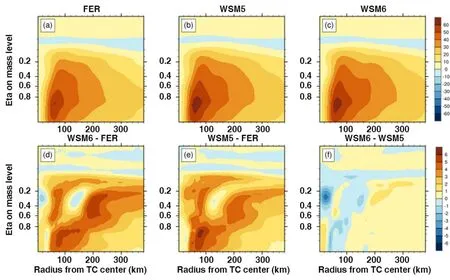
Fig.7.As in Fig.4 but for tangential wind(units:m s-1).In(a–c),negative and positive values indicate cyclonic and anticyclone fl ows,respectively.
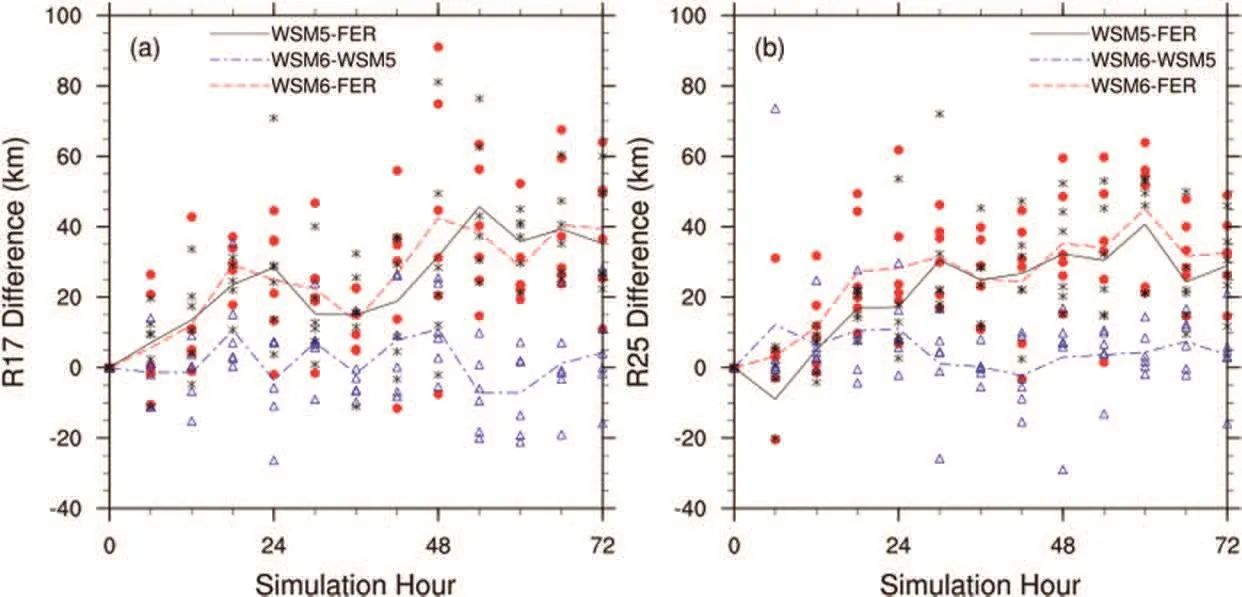
Fig.9.Diff erences among the microphysics schemes of(a)R17 and(b)R25 in the first 72 h of six TC simulations. Black asterisks,blue triangles and red dots are the spreads of diff erences between WSM5 and FER,WSM6 and WSM5, and WSM6 and FER from the six TC simulations,respectively.Black solid,blue dash-dotted and red dashed lines indicate their means,respectively.
Theinner-andouter-coresizes inthisstudyarede fined as theazimuthalmeanradiusofstorm-force(25ms-1;R25)and gale-force(17 m s-1;R17)10-m winds from the TC center, respectively.Figure 9 shows that the mean values of the differences among diff erent microphysics schemes in R17 and R25 are similar.This means that the percentage diff erence of R25 is higher than that of R17 because R17 is about two to three times larger than R25 in general,which is given from the climatology.This is expectedbecause,apart from the surface friction and upper-tropospheric divergence,the lowertroposphericin fl owcan also betriggeredbythe diabaticheating through the inner-core–induced intensification(section 3.2).Suchan intensificationprocesswouldconsequentlylead to the decrease in surface pressure and enhance the lowertropospheric in fl ow near the inner core such that absolute angular momentum is transported inward to expand the horizontal wind field,leading to the increase in TC size.Thestrongest lower-tropospheric in fl ow(e.g.Figs.4a–c)and the maximum lower-troposphericin fl ow diff erence(e.g.Figs.4d and e)are therefore found somewhere within the inner core. The lower-tropospheric in fl ow then decreases radially such that its enhancements when using the WSM5 and WSM6 schemes are very small in the outer-core region.These results imply that the inner-core size is much more sensitive to the choice of microphysics scheme(among FER,WSM5 and WSM6)when comparing to the outer-core size.
3.4. Discussion
Sun et al.(2015)recently examined the sensitivity of the track of Typhoon Megi(2010)to the WSM3,Lin,WSM6 and Thompson microphysics schemes.They found that the microphysics could a ff ect the activity of the subtropical high and potentially a ff ect the track.This somehow contradicts what we have found in this study,as well as the findings of some other studies(Yang and Ching,2005;Zhu and Zhang, 2006;Liand Pu,2008;Tao et al.,2011).It therefore remains unclear as to whether TC track is sensitive to the choice of microphysics scheme.More studies are needed.
On the other hand,the choice of microphysics scheme is found to be important in the simulation of TC intensity and size.The WSM5 and WSM6 schemes give a higher TC intensity and a larger size than the FER scheme in general,because they can give higher diabatic heating outside the eyewall in the rainbands,which consequently drives a stronger secondary circulation.To investigate why this is the case, the diabatic heating due to the microphysics processes is diagnosed.The model results coherently show that stronger diabatic heating is found within a 200 km radius from the TC center with the WSM5 and WSM6 schemes(e.g.Fig.5). The more diabatic heating is generated,the higher the potential for the air parcel to move upward.Part of the moisture condenses and falls as precipitation,but most of the air continues to rise to the upper troposphere and results in stronger upper-troposphericdivergence.Suche ff ects then enhancethe lower-troposphericin fl ow,and hence favor an increase in TC intensity and a growth in size(especially the inner-core size), because of the concept of the conservation of absolute angular momentum(Wang,2009;Fudeyasu and Wang,2011; Wang,2012;Chan and Chan,2013).Indeed,this is a kind of Sawyer–Eliassen balance(Buiet al.,2009).In addition, the present result evidences that the diabatic heating in the rapid filamentation zone mainly contributes to the increase in inner-core size,as revealed in Liet al.(2014,2015),because the diabatic heatingin the rapid filamentationzone(approximately 60–160 km from the TC center)is stronger in WSM5 and WSM6 than that in FER.Note that because the lower-tropospheric in fl ow that resulted from the inner-core–inducedintensificationdecreasesradially,morediabaticheating in the inner core does not necessarily lead to larger outercore size if R17 is much larger than the radius of maximum wind(RMW).
To understand why more diabatic heating is generated in the WSM5 and WSM6 schemes than in the FER scheme,the hydrometeor distributions(especially ice,snow,graupel and rain)and microphysics processes among these three schemes are investigated.Compared with the simulations from the FER scheme,those using the WSM5 and WSM6 schemes have less cloud water(e.g.Fig.10a),more rain(e.g.Fig. 10b),and more ice condensate(ice/snow/graupel;e.g.Fig. 10c)mixingratiosintheregionwithstrongerdiabaticheating (e.g.cf.Figs.5 and 10).This suggests the microphysics processes of autoconversion,freezingand accretionof cloud water by rain,snow and/or graupel,as well as the deposition of ice andsnow,arestrongerin theWSM5 and WSM6 schemes. Therefore,the WSM5 and WSM6 schemes result in more diabatic heating generation than the FER scheme.The detailed calculation comparisons of the microphysics processes among the schemes are not explicitly discussed in this study because they involve a lot of diff erent empirical parameterizations,assumptions,simplifications etc.(see Rogers et al., 2001;Hong et al.,2004;Hong et al.,2006 for details).A more comprehensive discussion of these is beyond the scope of this paper.
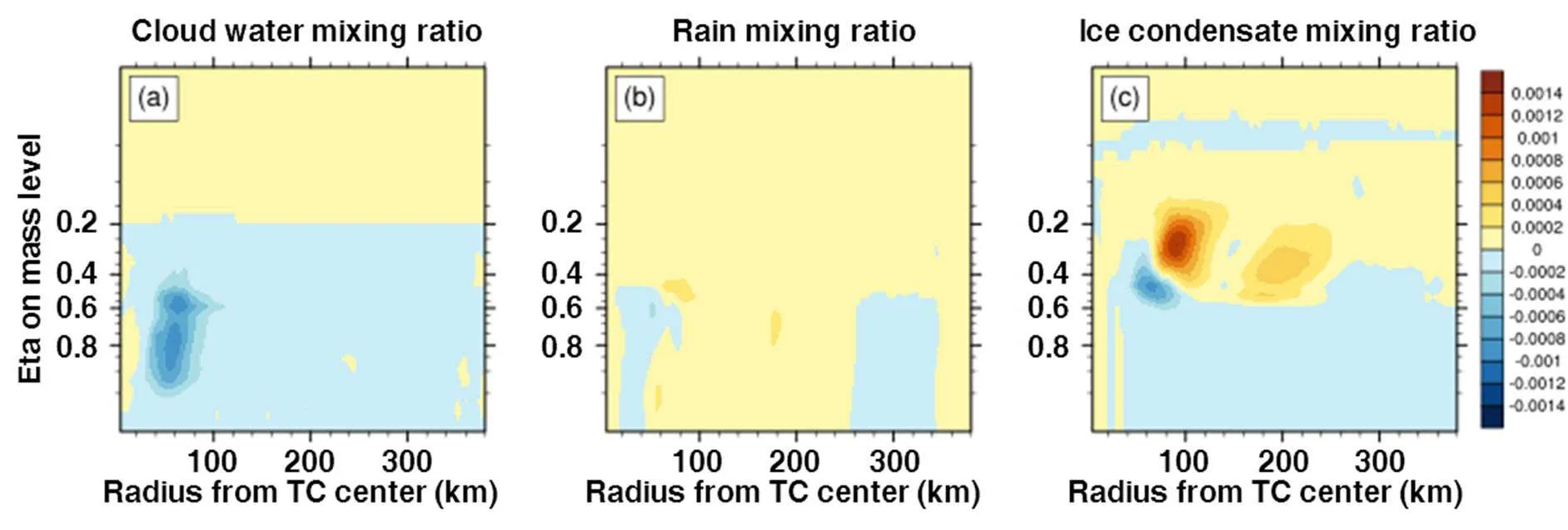
Fig.10.Radius–height plots of the diff erence in 24-h averaged azimuthal mean(a)cloud water mixing ratio,(b)rain mixing ratio,and(c)ice condensate mixing ratio between T25 and T48 in the case of Soulik among the WSM5 and FER schemes.Units: dimensionless(g kg-1).
In addition,the diabatic heating diff erence between the simulations with the WSM5 and WSM6 schemes are foundto be small and uneven in general(e.g.Fig.5f).This is likely due to the small contribution of the graupel processes to the total heating,such that there is no significant intensity and size deviations among the cases(cf.the WSM5 and WSM6 schemes in Figs.2 and 9).The results of this study could therefore suggest that the TC intensity and size(both R17 and R25)may not be sensitive to the inclusion of graupel microphysics processes.More work is needed to verify this in the future.
Note that similar results are also found in the other five TC cases,and are therefore not discussed in detail in this study.However,caution should be exercised insofar as that althoughconsistent results are found,theymay not be universally applicabledueto the limitedtesting(sixTC cases in this study).In order to conduct a quantitatively significant investigation,more experiments,and TC cases,are needed.This study should be treated as a first step toward showing the potential impacts of three mainstreammicrophysicsschemes on the simulated TC size.
4. Conclusions and discussion
The impacts of the choice of microphysics scheme on the simulation of TC size are studied using the Advanced Hurricane WRF model.Six TCs in the 2013 western North Pacific typhoon season and three mainstream microphysics schemes–FER,WSM5 and WSM6–are investigated.The inner-and outer-core sizes are de fined as the azimuthal mean radius of storm-force(25 m s-1;R25)and gale-force(17 m s-1;R17)10-m winds from the TC center,respectively.All the results(18 experiments in total)consistently show that the simulated TC track is not sensitive to these three microphysics schemes,which is consistent with results from previous studies.On the other hand,the simulated TC intensity and inner-core size are found to be significantly infl uenced by the choice of microphysics scheme.The simulated TC intensity and size(both R17 and R25)are similar in the simulations using the WSM5 and WSM6 schemes, and both are higher and larger than those using the FER scheme.The WSM5 and WSM6 schemes are shown to generate more diabatic heating then the FER scheme,which could be the main reason for such results.More diabatic heating could lead to higher upward motion,and hence result in higher upper-tropospheric divergence,lower-tropospheric convergence and precipitation rate.This consequently induces higher in fl ows at the lower troposphere and gives higher TC intensity and larger size(the inner-core size especially).It is important to note that this is a six-case sensitivity study,so the conclusionsdrawnshouldbemore reliable than those from single case studies.This paper is helpful for explaining the impacts of various mainstream microphysics schemes on the simulation of TC track,intensity and,particularly,size.
The sensitivity of three mainstream cumulus parameterizations[Kain–Fritsch(Kain,2004),Tiedtke(Tiedtke,1989; Zhang et al.,2011),and New Simplified Arakawa–Schubert (Han and Pan,2011)]on TC size has also been examined (not shown because it is not the focus of this study).The simulated TC track,intensity and size are found to be insensitive to such cumulus parameterizations in the first 72 h of simulation in general.In addition,comparing the relative importance of the microphysics schemes and cumulus parameterizations,the impacts of microphysics schemes on the simulated TC size are higher than those from the cumulus parameterizations.
Note again that the objective of the present study is not to search for the“best”microphysics scheme or matrix for TC prediction in WRF,although it is undoubtedly important. Many more numerical experiments and sensitivity tests have to be carried out in orderto achievethis,andthis is left forfuture work.Moreover,although the radiative forcing is likely an important factor in TC track,intensity and size(Fovell et al.,2010;Bu et al.,2014),the objective of this study was not to investigate diff erent radiation schemes or the coupling between the microphysics scheme and the radiation scheme. The idea of this study was that,given the same radiation scheme,diff erent microphysics schemes might give diff erent simulationsof intensity andsize becauseofthe heatingthat is generated being diff erent in diff erent schemes.It is possible that diff erentradiation schemes could negateor enhance such heating,but this is not the point of the present paper.
Acknowledgements.This study was supported by the Hong Kong Research Grants Council(Grant CityU 11300214).Most of the data analyses and visualizations were post-processed by the NCAR Command Language Version 6.2.0(http://dx.doi.org/ 10.5065/D6WD3XH5).
REFERENCES
Brutsaert,W.,1975:A theory for local evaporation(or heat transfer)from rough and smooth surfaces at ground level.Water Resour.Res.,11,543–550,doi:10.1029/WR011i004p00543.
Bu,Y.P.,R.G.Fovell,and K.L.Corbosiero,2014:In fl uence of cloud–radiative forcing on tropical cyclone structure.J.Atmos.Sci.,71,1644–1662,doi:10.1175/JAS-D-13-0265.1.
Bui,H.H.,R.K.Smith,M.T.Montgomery,and J.Y.Peng,2009: Balanced and unbalanced aspects of tropical cyclone intensification.Quart.J.Roy.Meteor.Soc.,135,1715–1731,doi: 10.1002/qj.502.
Chan,K.T.F.,and J.C.L.Chan,2012:Size and strength of tropical cyclones as inferred from QuikSCAT data.Mon.Wea. Rev.,140,811–824,doi:10.1175/MWR-D-10-05062.1.
Chan,K.T.F.,and J.C.L.Chan,2013:Angular momentum transports and synoptic fl ow patterns associated with tropical cyclone size change.Mon.Wea.Rev.,141,3985–4007,doi: 10.1175/MWR-D-12-00204.1.
Chan,K.T.F.,and J.C.L.Chan,2014:Impacts of initial vortex size and planetary vorticity on tropical cyclone size.Quart.J. Roy.Meteor.Soc.,140,2235–2248,doi:10.1002/qj.2292.
Chan,K.T.F.,and J.C.L.Chan,2015a:Global climatology of tropical cyclone size as inferred from QuikSCAT data.Int.J. Climatol.,35,4843–4848,doi:10.1002/joc.4307.
Chan,K.T.F.,and J.C.L.Chan,2015b:Impacts of vortex intensity and outer winds on tropical cyclone size.Quart.J.Roy.Meteor.Soc.,141,525–537,doi:10.1002/qj.2374.
Chavas,D.R.,and K.A.Emanuel,2010:A QuikSCAT climatology of tropical cyclone size.Geophys.Res.Lett.,37,L18816, doi:10.1029/2010GL044558.
Chen,S.-H.,and W.-Y.Sun,2002:A one-dimensional time dependent cloud model.J.Meteor.Soc.Japan,80,99–118,doi: 10.2151/jmsj.80.99.
Donelan,M.A.,B.K.Haus,N.Reul,W.J.Plant,M.Stiassnie,H. C.Graber,O.B.Brown,and E.S.Saltzman,2004:On the limiting aerodynamic roughness of the ocean in very strong winds.Geophys.Res.Lett.,31,L18306,doi:10.1029/2004 GL019460.
Fovell,R.G.,and H.Su,2007:Impact of cloud microphysics on hurricane track forecasts.Geophys.Res.Lett.,34,L24810, doi:10.1029/2007GL031723.
Fovell,R.G.,K.L.Corbosiero,and H.C.Kuo,2009:Cloud microphysics impact on hurricane track as revealed in idealized experiments.J.Atmos.Sci.,66,1764–1778,doi:10.1175/ 2008JAS2874.1.
Fovell,R.G.,K.L.Corbosiero,A.Seifert,and K.N.Liou,2010: Impact of cloud-radiative processes on hurricane track.Geophys.Res.Lett.,37,L07808,doi:10.1029/2010GL042691.
Fudeyasu,H.,and Y.Q.Wang,2011:Balanced contribution to the intensification of a tropical cyclone simulated in TCM4: Outer core spin-up process.J.Atmos.Sci.,68,430–449,doi: 10.1175/2010JAS3523.1.
Goerss,J.S.,2000:Tropical cyclone track forecasts using an ensemble of dynamical models.Mon.Wea.Rev.,128,1187–1193,doi:10.1175/1520-0493(2000)128<1187:TCTFUA>2.0.CO;2.
Han,J.,and H.-L.Pan,2011:Revision of convection and vertical diff usion schemes in the NCEP Global Forecast System.Wea. Forecasting,26,520–533,doi:10.1175/WAF-D-10-05038.1.
Heming,J.,J.C.L.Chan,andA.M.Radford,1995:A newscheme for the initialisation of tropical cyclones in the UK Meteorological Office global model.Meteorological Applications,2, 171–184,doi:10.1002/met.5060020211.
Hill,K.A.,and G.M.Lackmann,2009:In fl uence of environmental humidity on tropical cyclone size.Mon.Wea.Rev.,137, 3294–3315,doi:10.1175/2009MWR2679.1.
Hong,S.-Y.,and J.-O.J.Lim,2006:The WRF Single-Moment 6-Class Microphysics Scheme(WSM6).Journal of the Korean Meteorological Society,42,129–151.
Hong,S.-Y.,J.Dudhia,and S.-H.Chen,2004:A revised approach to ice microphysical processes for the bulk parameterization of clouds and precipitation.Mon.Wea.Rev.,132,103–120, doi:10.1175/1520-0493(2004)132<0103:ARATIM>2.0.CO; 2.
Hong,S.-Y.,Y.Noh,and J.Dudhia,2006:A new vertical diff usion package with an explicit treatment of entrainment processes.Mon.Wea.Rev.,134,2318–2341,doi:10.1175/MWR3199.1.
Iacono,M.J.,J.S.Delamere,E.J.Mlawer,M.W.Shephard,S. A.Clough,and W.D.Collins,2008:Radiative forcing by long-lived greenhouse gases:Calculations with the AER radiative transfer models.J.Geophys.Res.,113,D13103,doi: 10.1029/2008JD009944.
Jim´enez,P.A.,J.Dudhia,J.F.Gonz´alez-Rouco,J.Navarro,J. P.Mont´avez,and E.Garc´ıa-Bustamante,2012:A revised scheme for the WRF surface layer formulation.Mon.Wea. Rev.,140,898–918,doi:10.1175/MWR-D-11-00056.1.
Kain,J.,2004:The Kain–Fritsch convective parameterization:An update.J.Appl.Meteor.,43,170–181,doi:10.1175/1520-0450(2004)043<0170:TKCPAU>2.0.CO;2.
Kessler,E.,1995:On the continuity and distribution of water substanceinatmosphericcirculations.AtmosphericResearch,38, 109–145,doi:10.1016/0169-8095(94)00090-Z.
Kimball,S.K.,and M.S.Mulekar,2004:A 15-year climatology of North Atlantic tropical cyclones.Part I:Size parameters.J. Climate,17,3555–3575,doi:10.1175/1520-0442(2004)017<3555:AYCONA>2.0.CO;2.
Kna ff,J.A.,S.P.Longmore,and D.A.Molenar,2014:An objective satellite-based tropical cyclone size climatology.J.Climate,27,455–476,doi:10.1175/JCLI-D-13-00096.1.
Krishnamurti,T.N.,R.Correa-Torres,G.Rohaly,and D.Oosterhof,1997:Physical initialization and hurricane ensemble forecasts.Wea.Forecasting,12,503–514,doi:10.1175/1520-0434(1997)012<0503:PIAHEF>2.0.CO;2.
Kurihara,Y.,M.A.Bender,R.E.Tuleya,and R.J.Ross,1990: Prediction experiments of Hurricane Gloria(1985)using a multiply nested movable mesh model.Mon.Wea.Rev.,118,2185–2198,doi:10.1175/1520-0493(1990)118<2185: PEOHGU>2.0.CO;2.
Leslie,L.M.,and G.J.Holland.1995:On the bogussing of tropical cyclones in numerical models:A comparison of vortex pro files.Meteor.Atmos.Phys.,56,101–110,doi:10.1007/ BF01022523.
Leslie,L.M.,J.F.Le Marshall,R.P.Morison,C.Spinoso,R. J.Purser,N.Pescod,and R.Seecamp,1998:Improved hurricane track forecasting from the continuous assimilation of high quality satellite wind data.Mon.Wea.Rev.,126,1248–1257,doi:10.1175/1520-0493(1998)126<1248:IHTFFT>2. 0.CO;2.
Li,Q.Q.,Y.Q.Wang,and Y.H.Duan,2014:E ff ects of diabatic heating and cooling in the rapid filamentation zone on structure and intensity of a simulated tropical cyclone.J.Atmos. Sci.,71,3144–3163,doi:10.1175/JAS-D-13-0312.1.
Li,Q.Q.,Y.Q.Wang,and Y.H.Duan,2015:Impacts of evaporationof rainwater ontropical cyclone structureandintensity–A revisit.J.Atmos.Sci.,72,1323–1345,doi:10.1175/JAS-D-14-0224.1.
Li,X.L.,and Z.X.Pu,2008:Sensitivity of numerical simulation of earlyrapid intensification of hurricane Emily(2005)to cloud microphysical and planetary boundary layer parameterizations.Mon.Wea.Rev.,136,4819–4838,doi:10.1175/2008 MWR2366.1.
Lin,Y.-L.,R.D.Farley,and H.D.Orville,1983:Bulk parameterization of the snow field in a cloud model.J.Climate Appl. Meteor.,22,1065–1092,doi:10.1175/1520-0450(1983)022<1065:BPOTSF>2.0.CO;2.
Liu,K.S.,and J.C.L.Chan,2002:Synoptic fl ow patterns associated with small and large tropical cyclones over the western NorthPacific.Mon.Wea.Rev.,130,2134–2142,doi:10.1175/ 1520-0493(2002)130<2134:SFPAWS>2.0.CO;2.
Merrill,R.T.,1984:A comparison of large and small tropical cyclones.Mon.Wea.Rev.,112,1408–1418,doi:10.1175/1520-0493(1984)112<1408:ACOLAS>2.0.CO;2.
Miyoshi,T.,T.Komori,H.Yonehara,R.Sakai,andM.Yamaguchi, 2010:Impact of resolution degradation of the initialcondition on typhoon track forecasts.Wea.Forecasting,25,1568–1573, doi:10.1175/2010WAF2222392.1.
Rappaport,E.N.,and Coauthors,2009:Advances and challenges at the National Hurricane Center.Wea.Forecasting,24,395–419,doi:10.1175/2008WAF2222128.1.
Rogers,E.,T.Black,B.Ferrier,Y.Lin,D.Parrish,and G.DiMego,2001:Changes to the NCEP Meso Eta Analysis and Forecast System:Increase in resolution,new cloud microphysics, modified precipitation assimilation,modified 3DVAR analysis.[Available online at http://www.emc.ncep.noaa.gov/mmb/ mmbpll/eta12tpb/.]
Rogers,R.,and Coauthors,2006:The intensity forecasting experiment:A NOAA multiyear field program for improving tropical cyclone intensity forecasts.Bull.Amer.Meteor.Soc.,87,1523–1537,doi:10.1175/BAMS-87-11-1523.
Skamarock,W.C.,and Coauthors,2008:A description of the Advanced Research WRF version 3.NCAR Tech.Note NCAR/ TN-4751STR,113 pp.[Available online at http://www2. mmm.ucar.edu/wrf/users/docs/arw v3.pdf.]
Smith,R.K.,C.W.Schmidt,and M.T.Montgomery,2011:An investigation of rotational in fl uences on tropical-cyclone size and intensity.Quart.J.Roy.Meteor.Soc.,137,1841–1855, doi:10.1002/qj.862.
Srinivas,C.V.,R.Venkatesan,D.V.Bhaskar Rao,and D.HariPrasad,2007:Numerical simulationof Andhra severecyclone (2003):Model sensitivity to the boundary layer and convection parameterization.Pure Appl.Geophys.,164,1465–1487, doi:10.1007/s00024-007-0228-1.
Sun,Y.,Z.Zhong,and W.Lu,2015:Sensitivityof tropical cyclone feedback on the intensity of the western Pacific subtropical high to microphysics schemes.J.Atmos.Sci.,72,1346–1368, doi:10.1175/JAS-D-14-0051.1.
Tao,W-K.,J.J.Shi,S.S.Chen,S.Lang,P.-L.Lin,S.-Y.Hong,C. Peters-Lidard,and A.Hou,2011:The impact of microphysical schemes on hurricane intensity and track.Asia-Pacific Journal of Atmospheric Sciences.,47,1–16,doi:10.1007/ s13143-011-1001-z.
Tewari,M.,and Coauthors,2004:Implementation and verification of the unified Noah land surface model in the WRF model. Presented at the 20th Conference on Weather Analysis and Forecasting/16th Conference on Numerical Weather Prediction,Seattle,Wash.,Amer.Meteor.Soc.
Tiedtke,M.,1989:A comprehensive mass fl ux scheme for cumulus parameterization in large-scale models.Mon.Wea.Rev.,117,1779–1800,doi:10.1175/1520-0493(1989)117<1779: ACMFSF>2.0.CO;2.
Torn,R.D.,2010:Performance of a mesoscale ensemble Kalman filter(EnKF)during the NOAA high-resolution hurricane test.Mon.Wea.Rev.,138,4375–4392,doi:10.1175/2010 MWR3361.1.
Wang,Y.Q.,2002:An explicit simulation of tropical cyclones with a triply nested movable mesh primitive equation model-TCM3.Part II:Model re finements and sensitivity to cloud microphysics parameterization.Mon.Wea.Rev.,130,3022–3036,doi:10.1175/1520-0493(2002)130<3022:AESOTC>2. 0.CO;2.
Wang,Y.Q.,2009:How do outer spiral rainbands a ff ect tropical cyclone structure and intensity?J.Atmos.Sci.,66,1250–1273,doi:10.1175/2008JAS2737.1.
Wang,Y.Q.,2012:Recent research progress on tropical cyclone structure and intensity.Tropical Cyclone Research and Review,1,254–275,doi:10.6057/2012TCRR02.05.
Xu,J.,and Y.Q.Wang,2010a:Sensitivity of tropical cyclone inner-core size and intensity to the radial distribution of surface entropy fl ux.J.Atmos.Sci.,67,1831–1852,doi: 10.1175/2010JAS3387.1.
Xu,J.,and Y.Q.Wang,2010b:Sensitivity of the simulated tropical cyclone inner-core size to the initial vortex size.Mon. Wea.Rev.,138,4135–4157,doi:10.1175/2010MWR3335.1.
Yang,M.-J.,and L.Ching,2005:A modeling study of Typhoon Toraji(2001):Physical parameterization sensitivity and topographic e ff ect.Terrestrial,Atmospheric and Oceanic Sciences,16,177–213.
Yuan,J.N.,X.D.Wang,Q.L.Wan,and C.X.Liu,2007:A 28-year climatological analysis of size parameters for Northwestern Pacific tropical cyclones.Adv.Atmos.Sci.,24,24–34,doi: 10.1007/s00376-007-0024-y.
Zhang,C.X.,Y.Q.Wang,and K.Hamilton,2011:Improved representation of boundary layer clouds over the southeast Pacific in ARW-WRF using a modified Tiedtke cumulus parameterization scheme.Mon.Wea.Rev.,139,3489–3513,doi: 10.1175/MWR-D-10-05091.1.
Zhu,T.,and D.-L.Zhang,2006:The impact of the storm-induced SST cooling on hurricane intensity.Adv.Atmos.Sci.,23,14–22,doi:10.1007/s00376-006-0002-9.
Zou,X.L.,and Q.N.Xiao,2000:Studies on the initialization and simulation of a mature hurricane using a variational bogus data assimilation scheme.J.Atmos.Sci.,57,836–860,doi: 10.1175/1520-0469(2000)057<0836:SOTIAS>2.0.CO;2.
:Chan,K.T.F.,and J.C.L Chan,2016:Sensitivity of the simulation of tropical cyclone size to microphysics schemes.Adv.Atmos.Sci.,33(9),1024–1035,
10.1007/s00376-016-5183-2.
∗Corresponding author:Kelvin T.F.CHAN
Email:Kelvin.T.F.Chan@my.cityu.edu.hk
 Advances in Atmospheric Sciences2016年9期
Advances in Atmospheric Sciences2016年9期
- Advances in Atmospheric Sciences的其它文章
- Impacts of the Diurnal Cycle of Solar Radiation on Spiral Rainbands
- Abrupt Summer Warming and Changes in Temperature Extremes over Northeast Asia Since the Mid-1990s:Drivers and Physical Processes
- A Timescale Decomposed Threshold Regression Downscaling Approach to Forecasting South China Early Summer Rainfall
- Comparison of Nonlinear Local Lyapunov Vectors with Bred Vectors, Random Perturbations and Ensemble Transform Kalman Filter Strategies in a Barotropic Model
- Strengthened African Summer Monsoon in the Mid-Piacenzian
- Incorporation of a Dynamic Root Distribution into CLM4.5:Evaluation of Carbon and Water Fluxes over the Amazon
